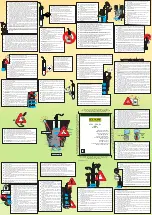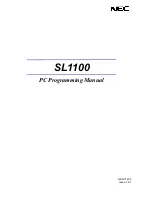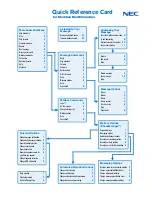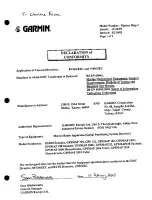
3 Prevention of Electro Static Discharge (ESD) to
Electrostatically Sensitive (ES) Devices
Some semiconductor (solid state) devices can be damaged easily by electricity. Such components commonly are called
Electrostatically Sensitive (ES) Devices. Examples of typical ES devices are integrated circuits and some field-effect transistors and
semiconductor “chip” components. The following techniques should be used to help reduce the incidence of component damage
caused by electro static discharge (ESD).
1. Immediately before handling any semiconductor component or semiconductor-equiped assembly, drain off any ESD on your
body by touching a known earth ground. Alternatively, obtain and wear a commercially available discharging ESD wrist strap,
which should be removed for potential shock reasons prior to applying power to the unit under test.
2. After removing an electrical assembly equiped with ES devices, place the assembly on a conductive surface such as aluminium
foil, to prevent electrostatic charge build up or exposure of the assembly.
3. Use only a grounded-tip soldering iron to solder or unsolder ES devices.
4. Use only an anti-static solder remover device. Some solder removal devices not classified as “anti-static (ESD protected)” can
generate electrical charge to damage ES devices.
5. Do not use freon-propelled chemicals. These can generate electrical charges sufficient to damage ES devices.
6. Do not remove a replacement ES device from its protective package until immediately before you are ready to install it. (Most
replacement ES devices are packaged with leads electrically shorted together by conductive foam, aluminium foil or
comparable conductive material).
7. Immediately before removing the protective material from the leads of a replacement ES device, touch the protective material
to the chassis or circuit assembly into which the device will be installed.
Caution
Be sure no power is applied to the chassis or circuit, and observe all other safety precautions.
8. Minimize body motions when handling unpackaged replacement ES devices. (Otherwise harmless motion such as the brushing
together of your clothes fabric or the lifting of your foot from a carpeted floor can generate static electricity (ESD) sufficient to
damage an ES device).
4 Handling the Lead-free Solder
4.1. About lead free solder (PbF)
Distinction of PbF P.C.B.:
P.C.B.s (manufactured) using lead free solder will have a PbF stamp on the P.C.B.
Caution:
·
Pb free solder has a higher melting point than standard solder; Typically the melting point is 50 - 70°F (30 - 40°C) higher. Please
use a high temperature soldering iron. In case of soldering iron with temperature control, please set it to 700 ± 20°F (370 ±
10°C).
·
Pb free solder will tend to splash when heated too high (about 1100°F/600°C).
·
When soldering or unsoldering, please completely remove all of the solder on the pins or solder area, and be sure to heat the
soldering points with the Pb free solder until it melts enough.
5
SA-AK330GC / SA-AK330GN
Содержание SA-AK330GC
Страница 9: ...8 Operation Procedures 9 SA AK330GC SA AK330GN ...
Страница 10: ...10 SA AK330GC SA AK330GN ...
Страница 55: ...15 Voltage Measurement 55 SA AK330GC SA AK330GN ...
Страница 56: ...56 SA AK330GC SA AK330GN ...
Страница 87: ...21 Troubleshooting Guide 87 SA AK330GC SA AK330GN ...
Страница 89: ...22 1 Deck Mechanism RAA4502 S 22 1 1 Deck Mechanism Parts Location 89 SA AK330GC SA AK330GN ...
Страница 90: ...90 SA AK330GC SA AK330GN ...
Страница 92: ...22 2 CD Loading Mechanism RD DAC026 S 22 2 1 CD Loading Mechanism Parts Location 92 SA AK330GC SA AK330GN ...
Страница 93: ...93 SA AK330GC SA AK330GN ...
Страница 95: ...22 3 1 Cabinet Parts Location 22 3 Cabinet 95 SA AK330GC SA AK330GN ...
Страница 96: ...96 SA AK330GC SA AK330GN ...
Страница 106: ...22 6 Packaging 106 SA AK330GC SA AK330GN PRT0411 P S J N A E ...






































